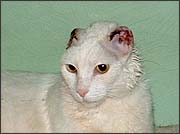 |
|||||||||||||||||||
|
|

We are the proud winners of the 2006 - 2009 winner of the Muse Medallion for Online Magazine by The Cat Writers? Association in their annual Communications Contest! (Photo courtesy of Weems Hutto).
On November 17, 2007 Felinexpress.com was honored to receive The President's Award by the Cat Writers' Association. We are very proud to have earned this distinction and will continue to provide quality information for all cat lovers.
Felinexpress.com Home > Cat Health > White Cats and Squamous Cell Carcinoma |
White Cats and Squamous Cell Carcinoma
 Found predominantly in white-haired, or light haired cats. Squamous Cell Carcinoma first appears as a scabby wound occurring on the ears, neck or nose. Starting off as running sores also known as feline solar dermatitis, these sores commonly occur on one or both of the cat's ears. This condition is exacerbated further by any added exposure to the sun. Blue-eyed white cats are the most susceptible, lacking the appropriate pigmentation of their skin to block out the harmful UV rays. This exposure to the sun’s rays causes the capillaries underneath the skin to rupture. Once the ruptures occur the cat becomes susceptible to skin cancer.
Found predominantly in white-haired, or light haired cats. Squamous Cell Carcinoma first appears as a scabby wound occurring on the ears, neck or nose. Starting off as running sores also known as feline solar dermatitis, these sores commonly occur on one or both of the cat's ears. This condition is exacerbated further by any added exposure to the sun. Blue-eyed white cats are the most susceptible, lacking the appropriate pigmentation of their skin to block out the harmful UV rays. This exposure to the sun’s rays causes the capillaries underneath the skin to rupture. Once the ruptures occur the cat becomes susceptible to skin cancer.
Without treatment and preventative measures; putting the cat indoors away from any sunlight, applying sunblock regularly to the ears, especially before noon when the sun is at its peak, veterinary intervention in form of ointments, antibiotics or other methods to halt the damage, skin cancer can quickly become either basil cell carcinoma (a benign cancer) or worse-case-scenario, squamous cell carcinoma (malignant cancer).
Although the sun is generally the main culprit, squamous cell carcinoma can occur when a cat has been badly burned, exposed to radiation or severe skin irritations result, predisposing the delicate skin to the damage of squamous cell carcinoma.
The outer part of a cat’s ear is called the pinna. This is the area that commonly shows eruption first. Because the fur on the outer ear of white cats is thinner than in other areas of the body, the solar radiation can inflect the most damage there.
In cats vulnerable to skin cancer, the first lesions can appear as early as three months of age. An early warning sign that your cat may be exposed would be the curling of the tips of his ears. Depending on the amount of time the cat is exposed to sunlight, the lesions can quickly advance, showing up as thin or thick-crusted, bloody scabs on the outer ear tips and the pinna. The skin begins to peel (like a bad sunburn) opening up the newer, under-developed skin to further damage.
Once the skin begins to peel back and the scabs start to become infected, the cat will instinctively scratch his ears wanting an end to the pain. Over time, the lesions can grow to resemble cauliflower or crater-like masses. In severe cases, there is a definite odor emanating from the ear tips. The surface can resemble a bloody scab, a white, creamy lesion or a gray mass.
Especially in warmer climates such as Hawaii, Florida and parts of the South, light-haired cats are increasingly susceptible to squamous cell carcinoma, specifically, the feral and stray cats with no caregivers to watch out for early warning signs.
Squamous cell carcinoma is quite invasive. The cancer can spread into the nasal cavities, up into the mouth into the lymph nodes or the lungs. Once this occurs, the cancer becomes resistant to most therapy and drug treatments.
Although squamous cell carcinoma is extremely rare in young cats (before three years of age) it can and does occur. A quick trip to the vet is a must. He will take a scraping and cytology of the ear in order to determine if the cat has SCC. If the lesions are determined to be malignant, the vet will recommend removal of the ear flaps.
If during the surgery, the ear flap is complety removed erasing all forms of visible cancer. the cat may be cured. But over time, if the cancer returns, then the treatment needed would be: radiation, hyperthermia (heating the tissue) & photodynamic therapy. Those are all only available at referral centers and the treatment can be costly.
Sunblock is not always effective. Cats typically love to rub their head against objects. This rubbing (or marking) can cause the sunblock to come off the ears. Since cats are such fastidious groomers, one good head washing will also remove most of the protection.
The best way to prevent squamous cell carcinoma is to avoid exposing your white cat to any form of sunshine. Although this may sound cruel, I assure you from personal experience that watching a cat go through the pain of dealing with ulcerated ears, weeping sores and major discomfort is far worse than depriving him of his time in the sun.
More cat breeds |
|
? Copyright 2006-2010 Felinexpress.com, All Rights Reserved
Privacy Statement - Disclaimer - About Me


